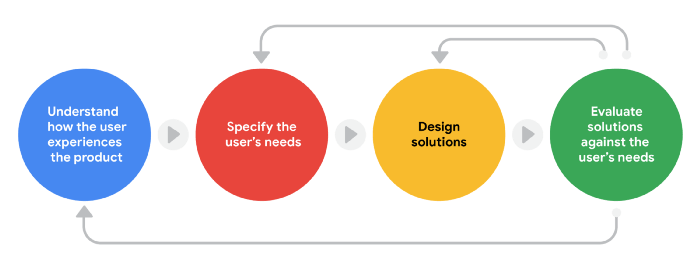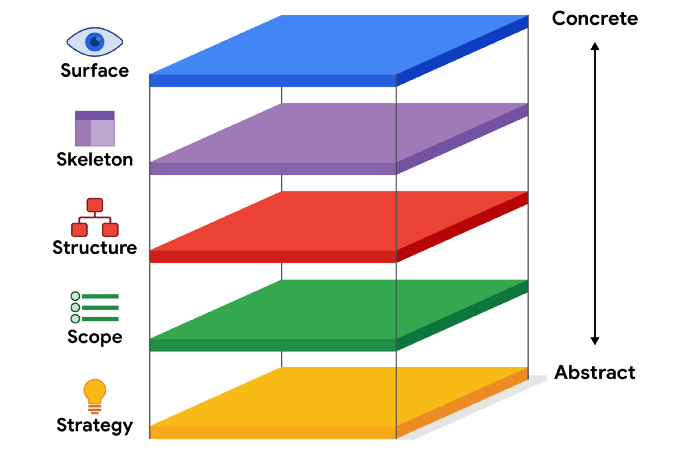Most UX designers follow a specific framework or process when approaching their work, from the first idea all the way through to the final launch of a product. As a reminder, a framework creates the basic structure that focuses and supports the problem you’re trying to solve, kind of like an outline for a project. You started to learn about frameworks in the video you just watched. This reading will dive into more detail about the user-centered design process, the five elements of UX design, and the design thinking process. You might be drawn to a particular framework, or your team might use one approach for each project. Every designer and every team is different! Regardless, it’s helpful to have a solid understanding of each framework before you start designing.
User-centered design process
Each phase of the user-centered design process focuses on users and their needs. It’s an iterative process, which means that designers go back to certain phases, again and again, to refine their designs and create the best possible product for their intended users. At the core of the user-centered design process is a deep empathy for the user. It’s not just about what a product does for a user, it’s about how the experience of interacting with the design makes the user feel. Here are the key steps in the user-centered design process:
Understand how the user experiences the product. You want to know how users will engage with your design, as well as the environment or context in which they’ll experience the product. Understanding this requires a lot of research, like observing users in action and conducting interviews, which we’ll explore more later.
Specify the user’s needs. Based on your research, figure out which user problems are the most important to solve.
- Design solutions. Come up with lots of ideas for designs that can address the user problems you’ve identified. Then, start to actually design those ideas!
- Evaluate the solutions you designed against the user’s needs. Ask yourself, does the design I created solve the user’s problem? To answer this question, you should test the product you designed with real people and collect feedback.
Notice how the arrows in the diagram indicate circular movement. This illustrates the iterative quality of the user-centered design process. Designers go back to earlier phases of the process to refine and make corrections to their designs. With the user-centered design process, you’re always working to improve the user’s experience and address the problems that users are facing!

The five elements of UX design
The five elements of UX design is a framework of steps that UX designers take to turn an idea into a working product. The five elements are, from bottom to top: strategy, scope, structure, skeleton, and surface. Think of these as a set of five layers, where each layer is dependent on the one below it.

Strategy: The bottom layer is strategy, where you lay a foundation of your design goals. These goals are based on user needs and the business objectives for the product.
Scope: The next layer is scope, where you determine the type of product you’re building. At this point, you will consider the kind of features and content you want to include in the product. Structure: The middle layer is structure. Here, you’ll figure out how to organize your design and how you want users to interact with the product. **
Skeleton**: The skeleton is the layout of the product. Just like the layout of our bones shapes our skin, the skeleton layer details how your design works — and like a skeleton, users won’t directly see its inner-workings.
Surface: The top layer, surface, represents how the product looks to the user. The surface represents the interface that users view and interact with. Think of the surface like the clothes or makeup you wear that are visible to the outside world.
Want to learn more? Check out this article about the five elements of user experience , which was originally developed by Jesse James Garrett. Or for a deep dive into the five elements, Garrett’s book is also an option to explore.

